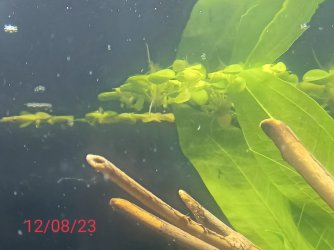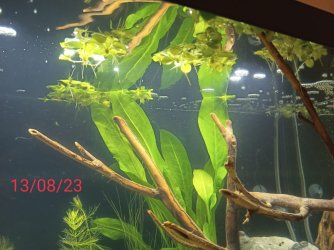Hello!
I have a standard 29 Gallon tank (75x35x40 cm). About three days ago I finished setting it up and adding my plants. At the time I had never heard of planted cycling so I was doing a fishless cycle using fish food. I added a decent amount of fish food to get the ammonia/nitrite cycling going, and also added beneficial bacteria per the bottle's instructions. Since then I have learnt about planted cycles. So my question is should I perform a water change (and remove as much of the remaining food as I can) or leave the tank be?
My frogbit has started to grow its roots and make new leaves.
11/08/23 15:47 (Test strip)
Ammonia: 0.25 ppm
Nitrite: 1 ppm
Nitrate: 25 ppm
12/08/23 10:12 (Liquid Test)
Ammonia: 0.50 ppm
Nitrite: 0.25 ppm
Nitrate: 10-20 ppm
12/08/23 22:27 (Liquid test)
Ammonia: 1 ppm
Nitrite: 0.25 ppm
Nitrate: 5 ppm
13/08/23 16:19 (Liquid test)
Ammonia: 1 ppm
Nitrite: 0.50 ppm
Nitrate: 10-20 ppm
I have a standard 29 Gallon tank (75x35x40 cm). About three days ago I finished setting it up and adding my plants. At the time I had never heard of planted cycling so I was doing a fishless cycle using fish food. I added a decent amount of fish food to get the ammonia/nitrite cycling going, and also added beneficial bacteria per the bottle's instructions. Since then I have learnt about planted cycles. So my question is should I perform a water change (and remove as much of the remaining food as I can) or leave the tank be?
My frogbit has started to grow its roots and make new leaves.
11/08/23 15:47 (Test strip)
Ammonia: 0.25 ppm
Nitrite: 1 ppm
Nitrate: 25 ppm
12/08/23 10:12 (Liquid Test)
Ammonia: 0.50 ppm
Nitrite: 0.25 ppm
Nitrate: 10-20 ppm
12/08/23 22:27 (Liquid test)
Ammonia: 1 ppm
Nitrite: 0.25 ppm
Nitrate: 5 ppm
13/08/23 16:19 (Liquid test)
Ammonia: 1 ppm
Nitrite: 0.50 ppm
Nitrate: 10-20 ppm



